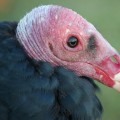A desert locust (Schistocerca gregaria) walking on uneven terrain uses both front legs equally to lead as it moves forward. Cover its left eye, however, and the insect will immediately begin favoring its right front leg—the leg it can still see with its uncovered eye—to lead its progress. This simple experiment, conducted recently by a team of scientists in Cambridge, England, has helped provide the first scientific evidence that locusts use vision to place their front legs when walking.
In their laboratory, scientists from the University of Cambridge, the University of Southampton and the Smithsonian Tropical Research Institute, observed as a number of adult locusts walked along a horizontal ladder. Recording each locust’s journey of 30 steps with high-speed video cameras they calculated each insect’s accuracy in placing its front feet on ladder rungs spaced at varying intervals. After covering the right or left eye of an insect, the scientists repeated the experiment and observed a significant increase in the error rate of rungs missed by the front leg on the side of the covered eye. The insects also began leading more with the leg they could still see with their uncovered eye.
This video shows locusts traversing a horizontal ladder in a laboratory at Cambridge University in experiments to test if these insects use vision to place their front legs. (Video courtesy Jeremy Niven)
“By combining different experiments, we showed that locusts use vision to place their legs,” says lead researcher Jeremy Niven, a scientist with the University of Cambridge and the Smithsonian. “This is another example of insects performing a behavior previously thought restricted to relatively big-brained animals with sophisticated motor control, such as humans, monkeys and octopuses.”
“Big-brained mammals have more neurons in their visual systems than a locust has in its entire nervous system, so our results show that small brains can perform complex tasks,” Niven adds. “Insects show us how different animals have evolved totally different strategies for doing similar tasks.”
These findings also deepen our understanding of the neural circuits of the locust, Niven adds. This is important because the locust has long been a model for the study of limb control. Insects such as the locust have been crucial to many breakthroughs in neuroscience, and insects are often the inspiration for limb control in robots. A paper outlining the study was published in the Jan. 12, 2010 issue of the journal “Current Biology.”
W45S9ES9K76P





